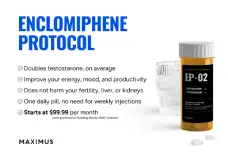madman
Super Moderator
* IA compared to LC-MS/MS in hypogonadal men overestimates significantly both the prevalence of biochemical Hy and TRT compensation both for TT and cfT. These results highlight the role of LC-MS/MS and SHBG assessments in every day clinical practice in the diagnosis and TRT monitoring of male Hy, avoiding unnecessary medication.
Background
Testosterone Replacement Therapy (TRT) in Hypogonadism (Hy) is started when total testosterone (TT) levels fall below 3.5 ng/ml in presence of a suggestive clinic, therefore the technology used to measure serum T levels is relevant. LC-MS/MS is the gold standard for sex steroids measurement, but it is mainly used for research, while IA is routinary used for clinical purpose. The use of LC-MS/MS in clinical labs is increasing, but its impact in the clinics remains unclear. We aimed to investigate the role of LC-MS/MS compared to IA in the diagnosis and management of male Hy.
Methods
A total of 116 Hypogonadotropic (70) or Hypergonadotropic (46) Hypogonadic men were enrolled irrespective of their treatment status, serum TT was assessed by LC-MS/MS and IA, together with SHBG for calculated free testosterone (cfT). Hy was defined according to the Italian Society of Andrology and Sexual Medicine (SIAMS) threshold: serum TT≤3.5 ng/mL and/or cfT<6.5 ng/dl. TT was quantified using CMIA DxI800 Beckman Coulter (IA) and Chrosystems MassChrom® Steroids in Serum/Plasma kit on Sciex CitrineTM (LC-MS/MS); cfT was calculated with the Vermeulen formula.
Results
Untreated and those patients under TRT were respectively 48 and 68, with a mean ± SD age of 45.98±17.56 years and a mean ± SD BMI of 28.09±5.36 kg/m2. Serum TT and cfT assessed with LC-MS/MS were directly related to serum TT (R2=0.6748, P < 0.001) and cfT (R2=0.8787, P < 0.001) assessed with IA, but the R2 did not show a precise concordance. Accordingly, the prevalence of biochemical Hy was significantly higher with IA than LC-MS/MS, for all Hy patients TT (59.5% vs 46.6%, OR 1.69, P = 0.025) and those untreated (87.5% vs 64.58%, OR 3.84, P = 0.011). A similar result was found even for cfT in all Hy (53.4% vs 39.7%, OR 1.75, P = 0.018) and the untreated ones (79.17% vs 58.33%, OR 2.71, P = 0.030). Correlation between serum TT measured by LC-MS/MS and IA was higher in the low (≤3.5 ng/mL) (R2=0.6877, P < 0.001) than in the normal to high (R2=0.4396, P < 0.001) range of serum TT, suggesting incongruence between the two in patients under T therapy.
Conclusions
IA compared to LC-MS/MS in hypogonadal men overestimates significantly both the prevalence of biochemical Hy and TRT compensation both for TT and cfT. These results highlight the role of LC-MS/MS and SHBG assessments in every day clinical practice in the diagnosis and TRT monitoring of male Hy, avoiding unnecessary medication.
Background
Testosterone Replacement Therapy (TRT) in Hypogonadism (Hy) is started when total testosterone (TT) levels fall below 3.5 ng/ml in presence of a suggestive clinic, therefore the technology used to measure serum T levels is relevant. LC-MS/MS is the gold standard for sex steroids measurement, but it is mainly used for research, while IA is routinary used for clinical purpose. The use of LC-MS/MS in clinical labs is increasing, but its impact in the clinics remains unclear. We aimed to investigate the role of LC-MS/MS compared to IA in the diagnosis and management of male Hy.
Methods
A total of 116 Hypogonadotropic (70) or Hypergonadotropic (46) Hypogonadic men were enrolled irrespective of their treatment status, serum TT was assessed by LC-MS/MS and IA, together with SHBG for calculated free testosterone (cfT). Hy was defined according to the Italian Society of Andrology and Sexual Medicine (SIAMS) threshold: serum TT≤3.5 ng/mL and/or cfT<6.5 ng/dl. TT was quantified using CMIA DxI800 Beckman Coulter (IA) and Chrosystems MassChrom® Steroids in Serum/Plasma kit on Sciex CitrineTM (LC-MS/MS); cfT was calculated with the Vermeulen formula.
Results
Untreated and those patients under TRT were respectively 48 and 68, with a mean ± SD age of 45.98±17.56 years and a mean ± SD BMI of 28.09±5.36 kg/m2. Serum TT and cfT assessed with LC-MS/MS were directly related to serum TT (R2=0.6748, P < 0.001) and cfT (R2=0.8787, P < 0.001) assessed with IA, but the R2 did not show a precise concordance. Accordingly, the prevalence of biochemical Hy was significantly higher with IA than LC-MS/MS, for all Hy patients TT (59.5% vs 46.6%, OR 1.69, P = 0.025) and those untreated (87.5% vs 64.58%, OR 3.84, P = 0.011). A similar result was found even for cfT in all Hy (53.4% vs 39.7%, OR 1.75, P = 0.018) and the untreated ones (79.17% vs 58.33%, OR 2.71, P = 0.030). Correlation between serum TT measured by LC-MS/MS and IA was higher in the low (≤3.5 ng/mL) (R2=0.6877, P < 0.001) than in the normal to high (R2=0.4396, P < 0.001) range of serum TT, suggesting incongruence between the two in patients under T therapy.
Conclusions
IA compared to LC-MS/MS in hypogonadal men overestimates significantly both the prevalence of biochemical Hy and TRT compensation both for TT and cfT. These results highlight the role of LC-MS/MS and SHBG assessments in every day clinical practice in the diagnosis and TRT monitoring of male Hy, avoiding unnecessary medication.













